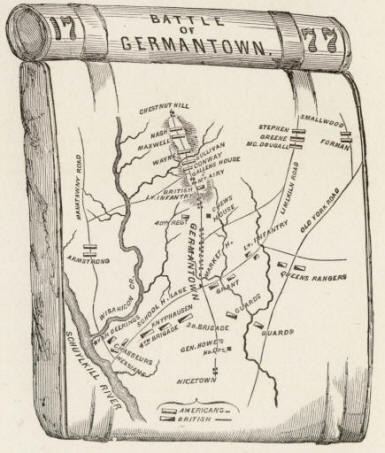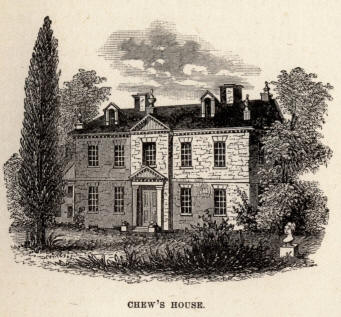|
This Site:
Discovery of America
The Explorers
Post Columbian Exploration
Thirteen Original Colonies
Colonization of America
Colonial Life
Colonial Days and Ways
Independence Movement
The Patriots
Prelude to War
Revolutionary War
Revolutionary War Battles
Overview of Revolutionary War
Revolutionary War
Timeline
Civil War
American Flag
Mexican War
Republic of Texas
Indians
|
 Germantown,
BATTLE OF. There were formidable obstructions in the
Delaware River below Philadelphia, placed there by the Americans,
and also two forts and a redoubt that commanded the stream. The
British fleet was in Delaware
Bay, September 25, 1777, but could not reach Philadelphia before
these obstructions were removed.
General Howe prepared
to assist his brother in removing these obstructions, and sent
strong detachments from his army to occupy the shores of the
Delaware below Philadelphia, which the Americans still held.
Perceiving the weakening of Howe's army, and feeling the necessity
of speedily striking a blow that should revive the spirits of the
Americans, it was resolved to attack the British army at Germantown.
George Washington had
been reinforced by Maryland
and New Jersey troops. His
army moved in four columns during the night of October 3, the
divisions of Sullivan and
Wayne, flanked by
General
Conway's brigade on the right, moving by way of Chestnut Hill, while
Armstrong, with Pennsylvania militia, made a circuit to gain the
left and rear of the enemy. The divisions of Greene and Stephen,
flanked by McDougall's brigade (two-thirds of the whole army), moved
on a circuitous route to attack the front of the British right wing,
while the Maryland and New Jersey militia, under
Smallwood and
Forman, marched to fall upon the rear of that wing. Lord Stirling,
with the brigades of Nash and Maxwell, formed the reserve. Howe's
force stretched across the country from Germantown. with a battalion
of light infantry and Simcoe's Queen's Rangers (American loyalists)
in the front. In advance of the left wing were other light infantry,
to support pickets on Mount Airy, and the extreme left was guarded
by Hessian yagers
(riflemen). Near the large stone mansion of Chief-Justice Chew (see
illustration), at the head of the village, was a strong regiment
under Colonel Musgrave. Germantown,
BATTLE OF. There were formidable obstructions in the
Delaware River below Philadelphia, placed there by the Americans,
and also two forts and a redoubt that commanded the stream. The
British fleet was in Delaware
Bay, September 25, 1777, but could not reach Philadelphia before
these obstructions were removed.
General Howe prepared
to assist his brother in removing these obstructions, and sent
strong detachments from his army to occupy the shores of the
Delaware below Philadelphia, which the Americans still held.
Perceiving the weakening of Howe's army, and feeling the necessity
of speedily striking a blow that should revive the spirits of the
Americans, it was resolved to attack the British army at Germantown.
George Washington had
been reinforced by Maryland
and New Jersey troops. His
army moved in four columns during the night of October 3, the
divisions of Sullivan and
Wayne, flanked by
General
Conway's brigade on the right, moving by way of Chestnut Hill, while
Armstrong, with Pennsylvania militia, made a circuit to gain the
left and rear of the enemy. The divisions of Greene and Stephen,
flanked by McDougall's brigade (two-thirds of the whole army), moved
on a circuitous route to attack the front of the British right wing,
while the Maryland and New Jersey militia, under
Smallwood and
Forman, marched to fall upon the rear of that wing. Lord Stirling,
with the brigades of Nash and Maxwell, formed the reserve. Howe's
force stretched across the country from Germantown. with a battalion
of light infantry and Simcoe's Queen's Rangers (American loyalists)
in the front. In advance of the left wing were other light infantry,
to support pickets on Mount Airy, and the extreme left was guarded
by Hessian yagers
(riflemen). Near the large stone mansion of Chief-Justice Chew (see
illustration), at the head of the village, was a strong regiment
under Colonel Musgrave.
 Washington's
army, moving stealthily, tried to reach Chestnut Hill before the
dawn (October 4), but failed. It was near sunrise when they emerged
from the woods on that eminence. The whole country was enveloped in
a thick fog. The British were surprised. The troops of Wayne and
Sullivan fell, unexpectedly and with heavy force, upon the British
infantry in front, and they were hurled back upon their main line in
confusion by a storm of grape-shot. This cannonade awakened
Cornwallis, who
was sleeping soundly in Philadelphia, unconscious of danger near.
Howe, too, nearer the army, was aroused from slumber, and arrived
near the scene of conflict to meet his flying battalions. Then he
hastened to his camp, to prepare his troops for action.
Musgrave
sent a part of his regiment to support the fugitives, and, with six
companies, took refuge in Chew's strong dwelling. He barricaded the
doors and lower windows, and made it a castle. From its upper
windows he poured such a volley of bullets upon
Woodford's pursuing
brigade that their march was checked. The fire of the American
small-arms upon the building was ineffectual. Finally Maxwell's
artillerists brought cannon to bear upon the house, but its strong
walls resisted the heavy, round shot. Then an attempt was made to
set fire to the mansion. This check in the pursuit brought back
Wayne's division, leaving Sullivan's flank uncovered. This event,
and the failure of
Greene to attack at the time ordered, disconcerted Washington's
plans. Greene's troops had fallen into confusion in the fog, as they
traversed the broken country, but they soon smote the British right
with force. The failure of the other troops to cooperate with them
by turning the British left caused Greene to fail, and the golden
opportunity to strike a crushing blow had passed. Washington's
army, moving stealthily, tried to reach Chestnut Hill before the
dawn (October 4), but failed. It was near sunrise when they emerged
from the woods on that eminence. The whole country was enveloped in
a thick fog. The British were surprised. The troops of Wayne and
Sullivan fell, unexpectedly and with heavy force, upon the British
infantry in front, and they were hurled back upon their main line in
confusion by a storm of grape-shot. This cannonade awakened
Cornwallis, who
was sleeping soundly in Philadelphia, unconscious of danger near.
Howe, too, nearer the army, was aroused from slumber, and arrived
near the scene of conflict to meet his flying battalions. Then he
hastened to his camp, to prepare his troops for action.
Musgrave
sent a part of his regiment to support the fugitives, and, with six
companies, took refuge in Chew's strong dwelling. He barricaded the
doors and lower windows, and made it a castle. From its upper
windows he poured such a volley of bullets upon
Woodford's pursuing
brigade that their march was checked. The fire of the American
small-arms upon the building was ineffectual. Finally Maxwell's
artillerists brought cannon to bear upon the house, but its strong
walls resisted the heavy, round shot. Then an attempt was made to
set fire to the mansion. This check in the pursuit brought back
Wayne's division, leaving Sullivan's flank uncovered. This event,
and the failure of
Greene to attack at the time ordered, disconcerted Washington's
plans. Greene's troops had fallen into confusion in the fog, as they
traversed the broken country, but they soon smote the British right
with force. The failure of the other troops to cooperate with them
by turning the British left caused Greene to fail, and the golden
opportunity to strike a crushing blow had passed.
In the fog that still prevailed, parties of
Americans attacked each other on the field; and it was afterwards
ascertained that, while the assault on Chew's house was in progress,
the whole British army were preparing to fly across the Schuylkill,
and rendezvous at Chester. At that moment of panic General Grey
observed that his flanks were secure, and
Knyphausen marched
with his whole force to assist the beleaguered garrison and the
contending regiments in the village. Then a short and severe battle
occurred in the heart of Germantown. The Americans could not discern
the number of their assailants in the confusing mist, when suddenly
the cry of a trooper, "We are surrounded!" produced a panic, and the
patriots retreated in great confusion. The struggle lasted about
three hours. The Americans lost about 600 killed, wounded, and
missing; the British about S00. Washington fell back to his
encampment on Skippack Creek. General Nash, while covering the
retreat with his brigade, was mortally wounded. |
 Germantown,
BATTLE OF. There were formidable obstructions in the
Delaware River below Philadelphia, placed there by the Americans,
and also two forts and a redoubt that commanded the stream. The
British fleet was in
Germantown,
BATTLE OF. There were formidable obstructions in the
Delaware River below Philadelphia, placed there by the Americans,
and also two forts and a redoubt that commanded the stream. The
British fleet was in  Washington's
army, moving stealthily, tried to reach Chestnut Hill before the
dawn (October 4), but failed. It was near sunrise when they emerged
from the woods on that eminence. The whole country was enveloped in
a thick fog. The British were surprised. The troops of Wayne and
Sullivan fell, unexpectedly and with heavy force, upon the British
infantry in front, and they were hurled back upon their main line in
confusion by a storm of grape-shot. This cannonade awakened
Washington's
army, moving stealthily, tried to reach Chestnut Hill before the
dawn (October 4), but failed. It was near sunrise when they emerged
from the woods on that eminence. The whole country was enveloped in
a thick fog. The British were surprised. The troops of Wayne and
Sullivan fell, unexpectedly and with heavy force, upon the British
infantry in front, and they were hurled back upon their main line in
confusion by a storm of grape-shot. This cannonade awakened